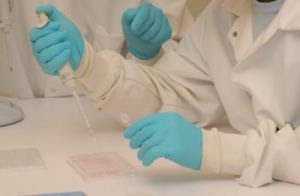A nine-year-old boy on Tuesday tested positive for swine flu taking the total number of cases to 31 in the country even as the govt said the US should "suo motu" start screening outbound passengers for symptoms of the disease.
New Delhi has also asked the developed countries to take action to contain and check the spread of swine flu at their end which would help stop the spread of the infection to the developing nations.
The fresh case was reported from Hyderabad where the boy arrived on 14th June from from New Jersey via London. "He has tested positive. He is on treatment. All his contacts are being traced," a Health Ministry official said.
Three passengers, including a staffer of a leading international airlines, have been quarantined at a hospital in Bangalore while a 22-year-old passenger was hospitalised in Kochi with symptoms of swine flu.
Of the 31 cases, 11 have been discharged. Rest of the passengers are all stable, the official said.
With mounting cases of swine flu in people coming from US, the Health Ministry said the US should "suo motu" start screening outbound passengers for symptoms of the disease.
Minister of State for Health and Family Welfare Dinesh Trivedi said the US is the "main source" of the virus for India with many travellers from that country testing positive for the flu.
INTERNAL MEDICINE The internal medicine blog , where you can have details on alternatice medicine , latest trends in medicine , new drugs in the market , school of medicine etc
One more swine flu case; India says US should screen passengers
Wednesday, June 17, 2009 at 3:44 AM Posted by Sajith
New Nanoparticles Could Lead To End Of Chemotherapy
at 3:35 AM Posted by Sajith

Nanoparticles specially engineered by University of Central Florida Assistant Professor J. Manuel Perez and his colleagues could someday target and destroy tumors, sparing patients from toxic, whole-body chemotherapies.Perez and his team used a drug called Taxol for their cell culture studies, recently published in the journal Small, because it is one of the most widely used chemotherapeutic drugs. Taxol normally causes many negative side effects because it travels throughout the body and damages healthy tissue as well as cancer cells.
The Taxol-carrying nanoparticles engineered in Perez's laboratory are modified so they carry the drug only to the cancer cells, allowing targeted cancer treatment without harming healthy cells. This is achieved by attaching a vitamin (folic acid) derivative that cancer cells like to consume in high amounts.
Because the nanoparticles also carry a fluorescent dye and an iron oxide magnetic core, their locations within the cells and the body can be seen by optical imaging and magnetic resonance imaging (MRI). That allows a physician to see how the tumor is responding to the treatment.
The nanoparticles also can be engineered without the drug and used as imaging (contrast) agents for cancer. If there is no cancer, the biodegradable nanoparticles will not bind to the tissue and will be eliminated by the liver. The iron oxide core will be utilized as regular iron in the body.
"What's unique about our work is that the nanoparticle has a dual role, as a diagnostic and therapeutic agent in a biodegradable and biocompatible vehicle," Perez said.
Perez has spent the past five years looking at ways nanotechnology can be used to help diagnose, image and treat cancer and infectious diseases. It's part of the quickly evolving world of nanomedicine.
The process works like this. Cancer cells in the tumor connect with the engineered nanoparticles via cell receptors that can be regarded as "doors" or "docking stations." The nanoparticles enter the cell and release their cargo of iron oxide, fluorescent dye and drugs, allowing dual imaging and treatment.
"Although the results from the cell cultures are preliminary, they are very encouraging," Perez said.
A new chemistry called "click chemistry" was utilized to attach the targeting molecule (folic acid) to the nanoparticles. This chemistry allows for the easy and specific attachment of molecules to nanoparticles without unwanted side products. It also allows for the easy attachment of other molecules to nanoparticles to specifically seek out particular tumors and other malignancies.
Perez's study builds on his prior research published in the prestigious journal Angewandte Chemie Int. Ed. His work has been partially funded by a National Institutes of Health grant and a Nanoscience Technology Center start-up fund.
"Our work is an important beginning, because it demonstrates an avenue for using nanotechnology not only to diagnose but also to treat cancer, potentially at an early stage," Perez said.
Perez, a Puerto Rico native, joined UCF in 2005. He works at UCF's NanoScience Technology Center and Chemistry Department and in the Burnett School of Biomedical Sciences in the College of Medicine. He has a Ph.D. from Boston University in Biochemistry and completed postdoctoral training at Massachusetts General Hospital, Harvard Medical School's teaching and research hospital.
Protein May Be Strongest Indicator Of Rare Lung Disease
at 3:27 AM Posted by Sajith

Researchers at the University of Cincinnati (UC) have discovered a protein in the lungs that can help in determining progression of the rare lung disease Idiopathic Pulmonary Fibrosis (IPF).Researchers say the protein—Serum surfactant protein A—is superior to other IPF predictors and could lead to better decisions about treatment and timing of lung transplantation.
The study, led by Brent Kinder, MD, is published in the June 4 edition of the journal Chest.
Surfactant proteins are lipoproteins that allow the lungs to stretch and function. These have previously been investigated by UC pulmonary researchers Frank McCormack, MD, and Jeffrey Whitsett, MD.
Kinder and colleagues report that Serum surfactant protein A is the strongest predictor of a patient's survival in the first year after diagnosis with IPF.
"A simple blood test may give us the information we need to help determine the short term risk of death in a patient with IPF," says Kinder, an assistant professor of medicine at the UC College of Medicine and pulmonologist with UC Physicians. "This protein is a stronger predictor of the severity of illness than age, symptoms or prognostic data, like breathing tests."
IPF is scarring of the lung. As the disease progresses, air sacs in the lungs become replaced by fibrotic scar tissue. Lung tissue becomes thicker where the scarring forms, causing an irreversible loss of the tissue's ability to carry oxygen into the bloodstream.
IPF is one of about 200 disorders called interstitial lung diseases, which affect the thick tissue of the lung as opposed to more common lung ailments—such as asthma or emphysema—that affect the airways.
IPF is the most common form of interstitial lung diseases and affects about 128,000 people in the United States, with an estimated 48,000 new cases diagnosed each year. There currently are no proven therapies or cures for IPF.
Kinder, director of UC's Interstitial Lung Disease Center, says this new indicator will allow doctors to determine the severity of the disease in a fast, effective manner and will help them decide the best way to go about treating it.
"It will allow us to come to a decision about how or if to treat the IPF patient and get them enrolled in clinical trials immediately," he says. "In severe cases, it can help in scheduling a lung transplant at the most optimal time for the patient.
"Overall, this discovery could help us define the window of opportunity to appropriately try more aggressive therapies and could greatly help improve the lives of those living with IPF."
This study was funded in part by a Support of Continuous Research Excellence (SCORE) grant from the National Institutes of Health and a UC Dean's Scholars award for clinical research.
Search
Labels
- Alzheimer's (10)
- Antibiotics (7)
- Anxiety (1)
- articles (2)
- Bacteria (1)
- behavioral abnormality (1)
- Bio technology (1)
- Brain (8)
- breast cancer (6)
- Cancer (40)
- cancer treatment (7)
- chemotherapy (6)
- Chlamydia (1)
- Cytology (3)
- Death (1)
- Diabetes Mellitus (7)
- Diet (17)
- DNA (1)
- Doctors (1)
- epilepsy (2)
- Fossil (1)
- fruits (1)
- genes (6)
- Genetics (13)
- Geriatrics (1)
- Health (12)
- Heart diseases (9)
- Herbal Medicine (2)
- HIV and AIDS (7)
- influenza (1)
- Inventions (1)
- IVF (1)
- latest findings (1)
- Life style (2)
- Lung Cancer (1)
- Lung Disease (9)
- Microbiology (1)
- Multiple Sclerosis (1)
- Nanotechnology (3)
- Neonatology (1)
- neurology (1)
- News (18)
- Parkinsonism (2)
- Prevention (1)
- Primates (1)
- Prostate cancer (1)
- Prosthetics (1)
- seizure (2)
- Skin (1)
- STD (2)
- Stem cells (9)
- Stroke (1)
- Surgery (2)
- Swine flu (11)
- Virus (1)
- weight loss (1)
Search The Web
Blog Archive
Minyx v2.0 template es un theme creado por Spiga. | Minyx Blogger Template distributed by eBlog Templates

